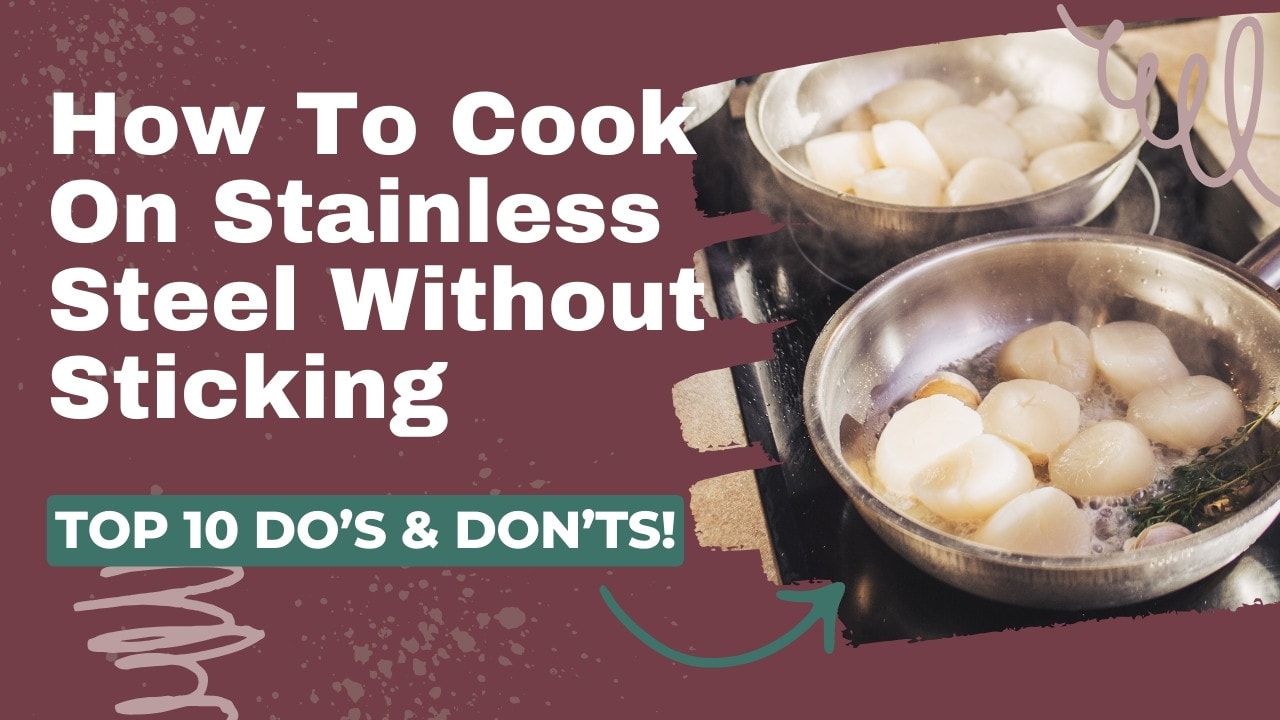In this article I’ll cover everything you need to know about how to cook with stainless steel without sticking. I’ve been doing it for decades (literally), and it’s easier than most people think.
So I wanted to share some do’s and don’ts, plus handy tips and secrets that’ll have you cooking like a chef in no time. Because, after all, stainless steel is the cookware of choice for chefs in professional kitchens.
Are Stainless Steel Pans Nonstick?
Technically, no, stainless steel pans are not nonstick. They aren’t covered in a water-repellent coating like ceramic or Teflon nonstick pans, and food won’t slide off of them unless you use enough oil and the right techniques.
How Do You Cook in Stainless Steel Pans Without Sticking?
There are 4 easy steps to prepare your stainless steel pan so that food won’t stick.
- Always start with a clean pan (no food residues or discoloration).
- Preheat your pan.
- Use the water test to make sure it’s at the right temperature.
- Use enough oil.
These four steps apply to cooking any type of food, from scrambling eggs at breakfast to sealing that perfectly cooked piece of crispy-skinned salmon for dinner.
Below, you’ll find my top 10 rules for cooking in stainless steel, plus bonus tips for how to cook tricky dishes like eggs, steak, and fish without them sticking – at least not very much.
Let’s dive in so you can get cooking.
10 Do’s and Don’ts For Cooking In Stainless Steel Pans Without Sticking.
1. Do Start with a Clean Pan
Discoloration in a stainless steel pan means it’s not clean. Burnt-on oils or food residues are sticky, impacting the stainless steel’s ability to cook food without sticking. If there is any discoloration (heat tint, rainbow discoloration, pitting) or burnt-on oil, clean your stainless steel before use.
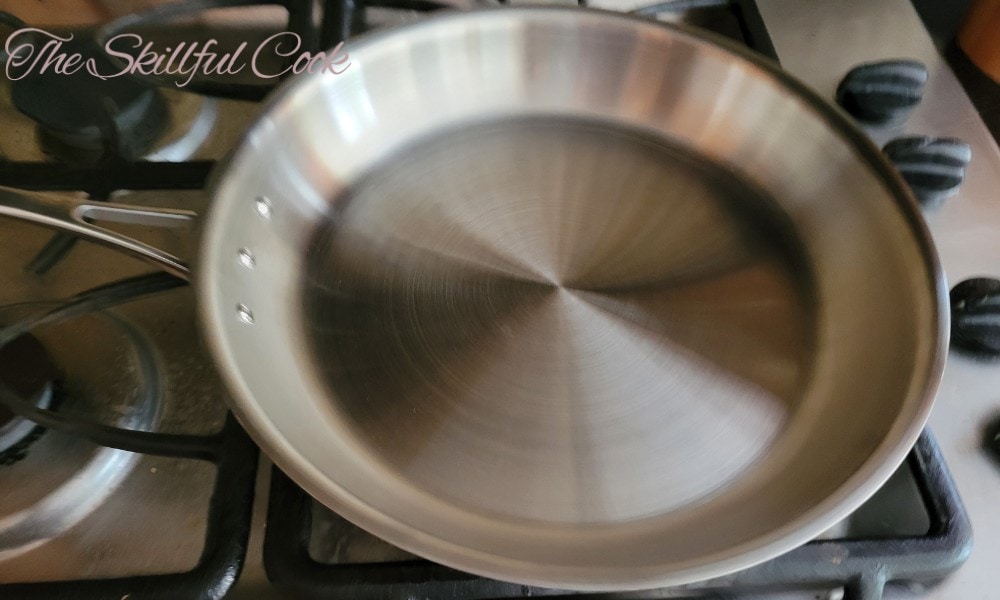
2. Do Always Preheat the Pan
Beautiful, shiny stainless steel looks nonstick, but on a microscopic level, stainless steel is porous. Proteins in the food will fill the pores and actually bond to the metal if the pan is not heated properly. As the pan preheats, the pores become smaller. If food is added too early before the pores shrink and the pan is hot enough to form a steam barrier, then food particles can get trapped in the pores.
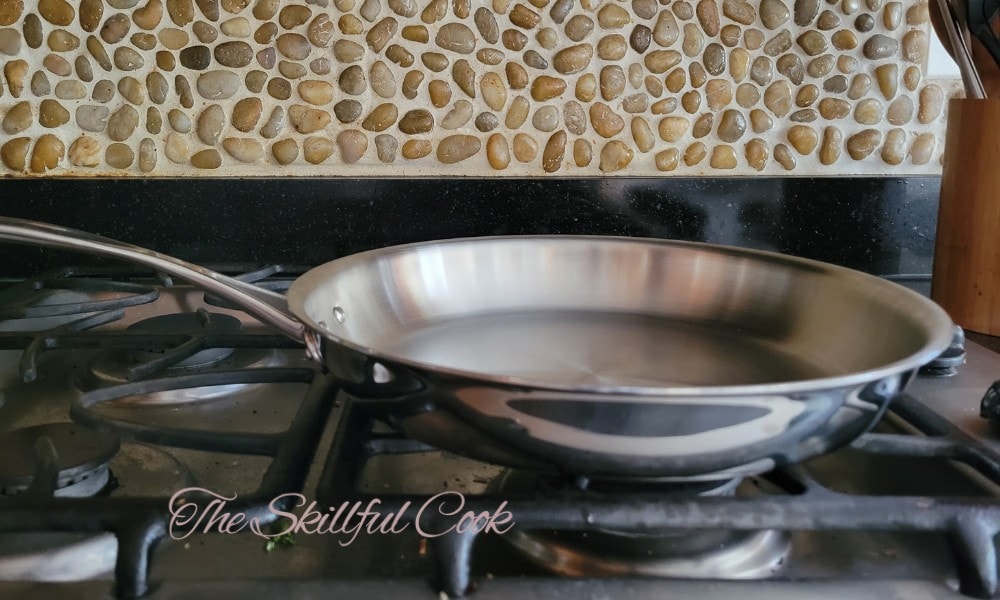
3. Do Use the Water Test to Know When the Pan is Hot Enough
When a stainless steel pan is hot enough, any food that you add will start to sizzle immediately and form a steam barrier, keeping the food from bonding to the pan. The water test is a fun way to tell if your pan is ready to start cooking. Science buffs call it the Leidenfrost Effect, and you can see it when you add a teaspoon of water to the pan and it slides around as a perfect bubble. No splashing, no sizzling, just gliding across the pan like a hockey puck over ice.
4. Do Add Oil
Once you see the water ball test working, pour the water out of the pan. Add your cooking oil of choice and give it a few seconds to come up to heat before adding any food. This creates a layer that will prevent the food protein from bonding with the bottom of your pan and sticking or burning on so it doesn’t lift. Never dry fry on stainless steel; food ends up seared to the bottom of your pan and is extremely hard to remove.
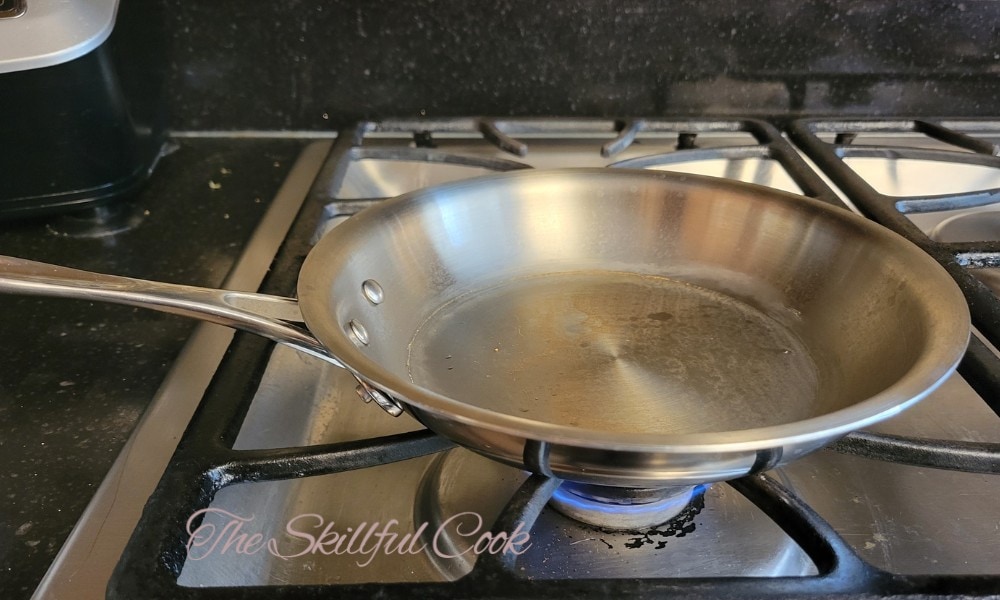
5. Don’t Overheat the Oil
Hot oil is dangerous, both for you and your stainless steel cookware. Every oil has a different heat tolerance, which is called a smoke point. Butter has a low smoke point, which means it burns and smokes quickly. Whereas peanut oil has a high smoke point, so it won’t smoke unless your pan is overheated.
6. Don’t Use Cooking Sprays
Don’t use cooking sprays; they burn too quickly. This rapid burn creates discoloration in a layer of burnt polymerized oil residue that is very hard to get off. Foods will stick to this layer, and you will have burnt-on food and a deeper cleaning process needed to remove it.
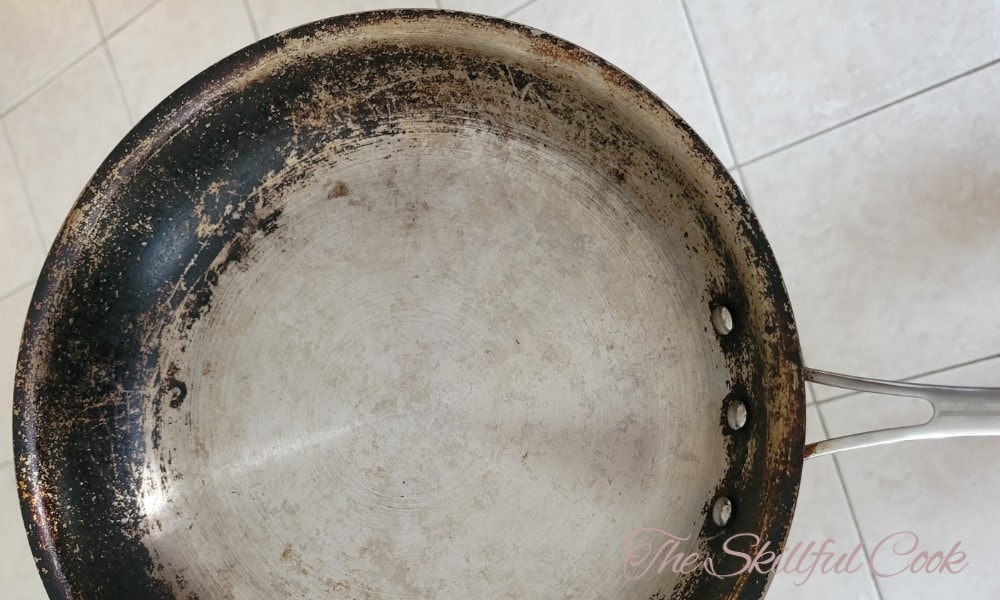
7. Don’t Add Cold (or Frozen) Foods
If you have time, try to safely temper your proteins before cooking them on stainless steel. This can mean letting them warm up in a bowl of water for a few minutes (not more than 30) before cooking.
There are three reasons not to add cold food to a hot pan:
- It’s dangerous. Adding cold food to a hot pan causes hot oil to spit all over the place. Adding frozen food to a hot pan will cause it to spit hot oil for a long time as moisture is released during the defrosting process.
- It will stick. Very cold or frozen proteins, especially eggs, dairy, and meat, will bond with the metal of the pan and become burnt on and difficult to remove.
- Adding cold to hot causes thermal shock. Adding frozen to hot can cause severe thermal shock, increasing the chance of warping or buckling lower-grade stainless steel.
8. Do Wait for Food to Release Before Turning
When you add food to a stainless steel pan, some of it may still be trapped in the pores of the pan, especially if the food cools the pan when it touches it. But as the pan comes back up to heat, the pores will shrink again and release the food. So give protein-rich foods a moment to cook and release naturally before you try to turn them.
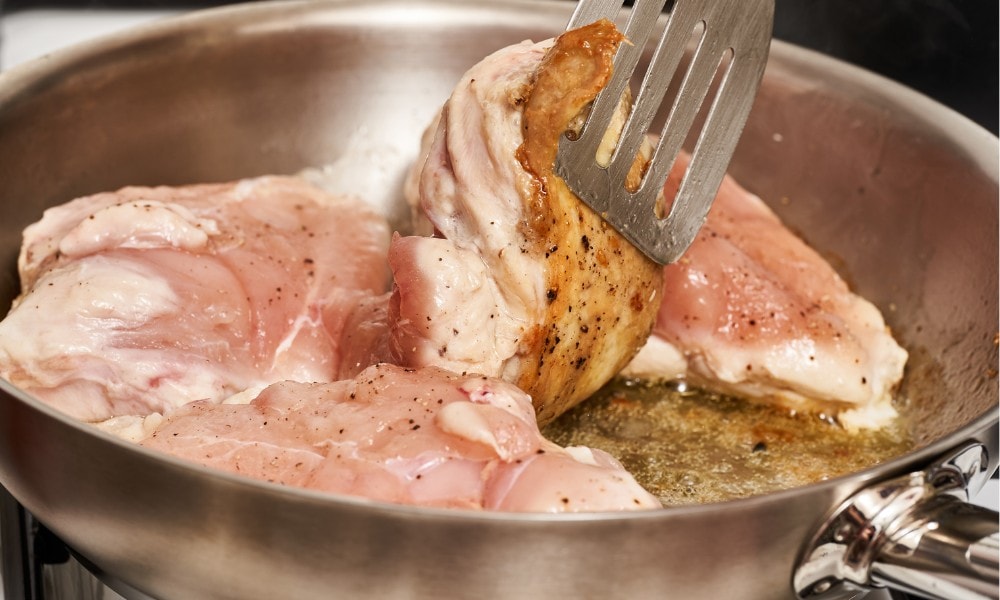
It takes practice to tell when this happens, but trying it is the best way to learn.
9. Don’t Crowd The Pan
It’s a hassle to have to cook in batches, but packing too much food into a stainless steel pan leads to a sticky situation! The food may make irregular food contact with the pan, causing uneven heat transfer that can cause your food to stick to the bottom of the pan.
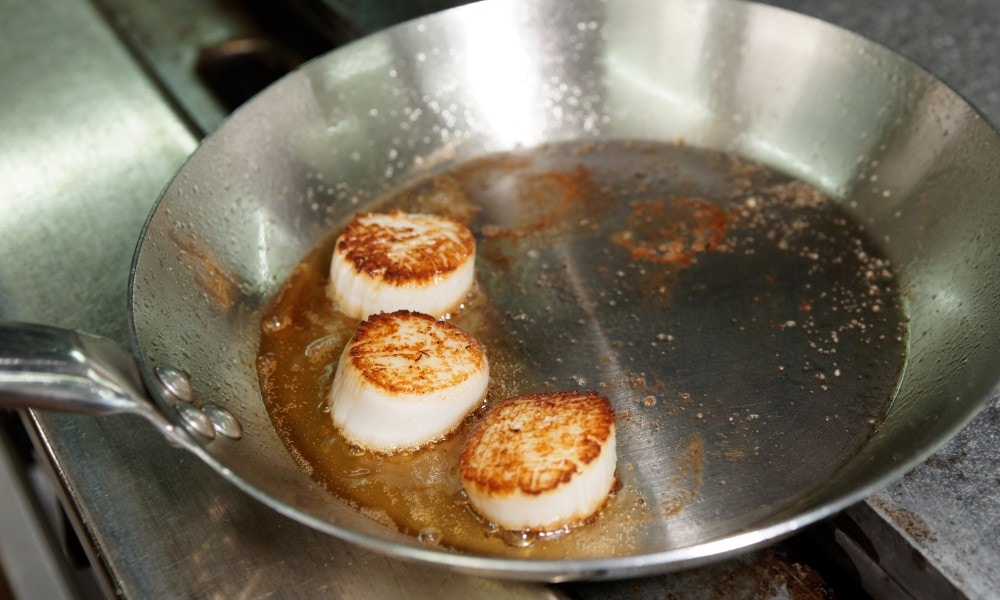
If you are making steak medallions, or fish, or even zucchini fritters and the pieces are almost touching each other, the moisture will release faster from the food than it can evaporate on the open surfaces of the pan – so your food ends up steaming instead of browning. Without enough room on the pan, you can’t achieve that wonderful caramelization that provides crisp golden crusts to treat your tastebuds,
10. Do Consider Seasoning Your Pan
To season stainless steel cookware is a personal choice. It’s easy to do, and personally, I’ve found that it enhances the dishes you cook, adding a subtle depth of flavor. But remember, when a pan is seasoned, it won’t have that shiny stainless steel look.
Pro Tips
Tip to Cook Eggs Without Sticking
You look like a true chef when fluffy scrambled eggs tumble out of your stainless steel pan, or a perfect French omelet slides right out onto the plate without sticking.
Here’s how you do it:
- Heat the pan over medium heat
- While that’s heating, prepare your ingredients – chop fresh herbs, scramble your eggs
- Test readiness using the water test (section 3 above)
- Add cooking oil of choice – oil, butter, ghee, lard
- Pour eggs into the pan and let cook until it lifts easily
- Using a silicone scraper, gently scrape the eggs towards the center of the pan
- Repeat until the eggs are cooked and fluffy.
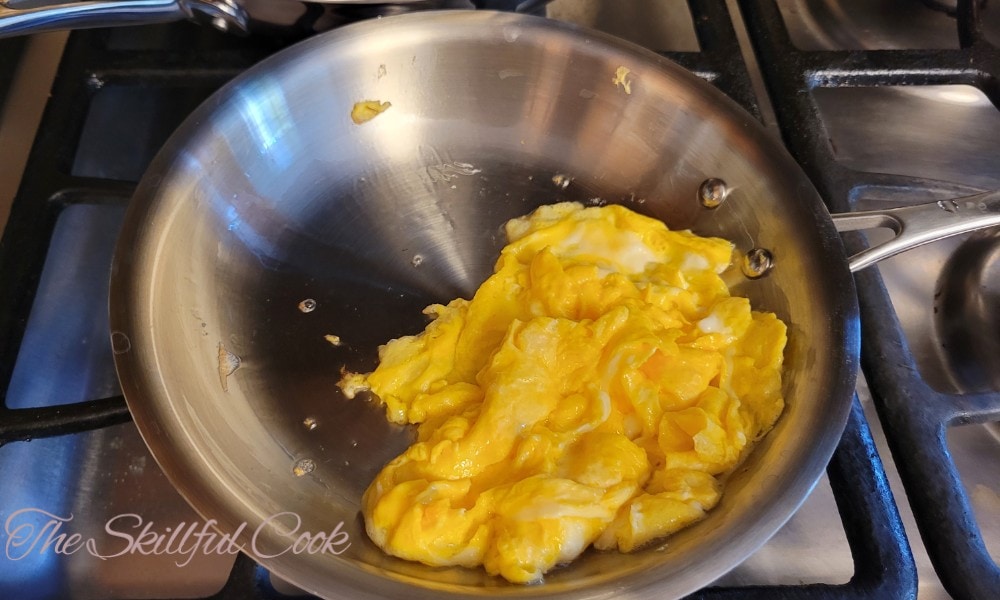
The Secret to perfection: if making an omelet, pour it into the pan and shake from side to side, creating a perfect even layer. Add your herbs once the eggs are nearly cooked, then the cheese just before you serve. The heat of the eggs, when folded over, will melt the cheese perfectly.
Tip to Cook Steak Without Sticking
Cooking the perfect steak is what stainless steel’s excellent heat dispersal and retention was meant to do. Here’s how you do it:
- Temper your steak (see video below). Bringing it to room temperature while adding your seasonings ensures a succulent steak and prevents oil buildup. It also avoids hot oil spitting when added to the pan or thermal shock to your cookware by adding cold food to a hot pan.
- Heat pan over medium heat.
- Test when ready using the water test (section 3 above).
- Add a tiny amount of oil (1 tablespoon) to the pan AND your steak. A tablespoon of foil rubbed on the steak is all that’s needed to prevent an over-oily steak.
- Place your steak in the pan and leave it for a few minutes (2-4 minutes, depending on preference) to finish cooking.
The Secret to perfection: choose the right size pan for how many steaks you’re cooking. For a perfect sear, they want room without touching.
Tip to Cook Salmon Without Sticking
You only have about 10-15 minutes to fry a perfect salmon filet before it’s overcooked. Here’s how to do it:
- Season your salmon with salt and pepper to taste.
- Heat pan over medium heat.
- Test it’s ready using the water test (section 3 above).
- Add oil (I like olive oil; it forms a great crust) and heat until shimmering.
- Place salmon filet in the pan skin side up.
- Cook until golden and crisp. Don’t touch it. Let it sear and seal for about 4 – 5 minutes to form that lovely golden crust.
- Gently flip each filet and reduce the heat a little so as to not burn the skin.
- Cook for a further 4 -5 minutes (to your liking).
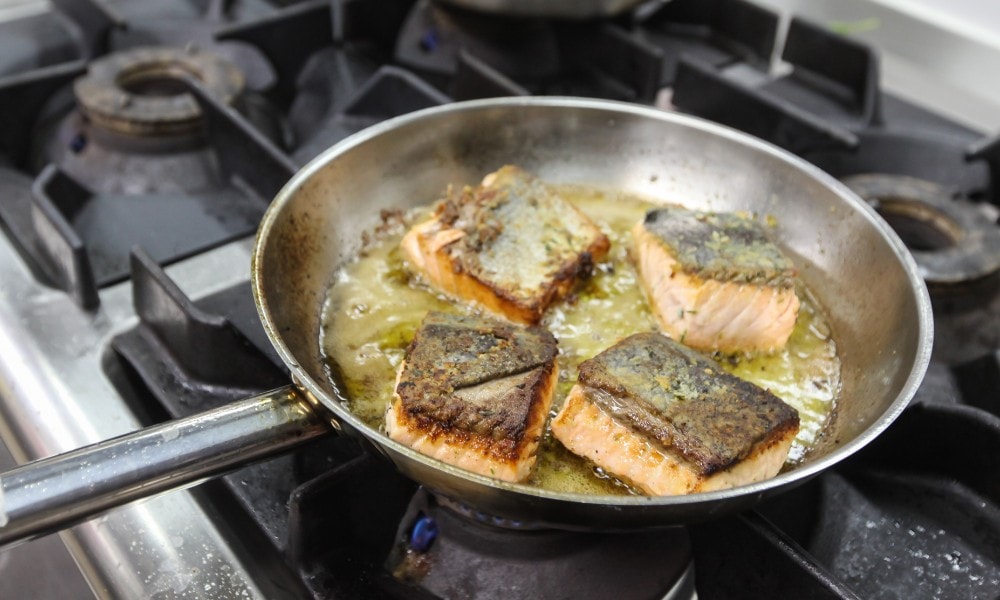
The Secret to perfection: choose the right-sized filets. A 6-ounce filet is a perfect size that will cook all the way through the interior while searing to form that coveted crusty skin on the exterior.
Cleaning Stainless Steel Cookware
When you cook with stainless steel correctly, cleaning it will be easy. Just allow it to cool and wash with warm, soapy water. But if something has gone wrong and there are hard to remove food residues, discoloration, or burnt-on foods or oils, then a deeper clean is needed.
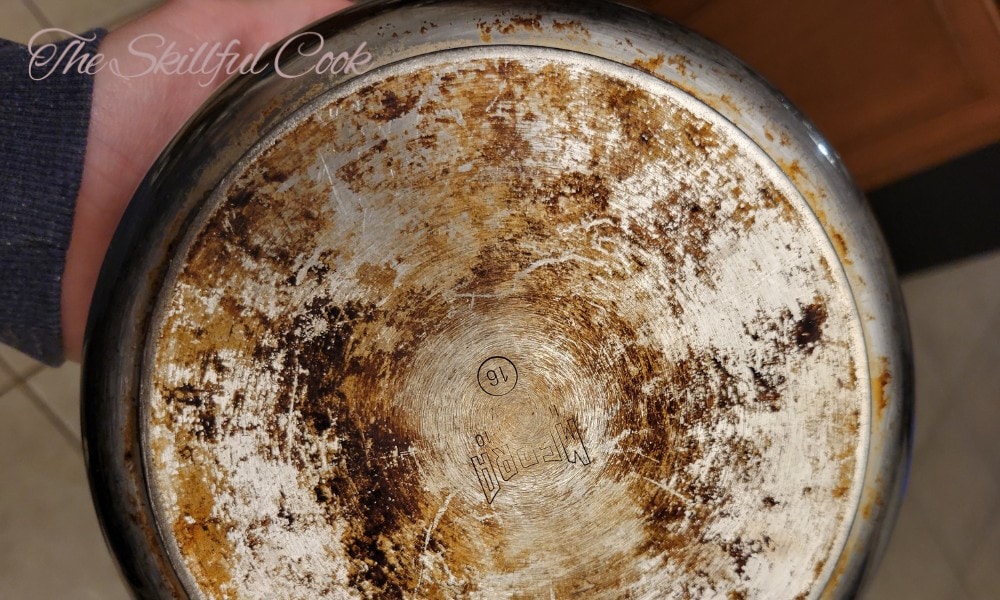
To clean burnt stainless steel, use equal parts vinegar and water boiled in the pan for 5 -10 minutes will lift just about anything. Gently scrape the bottom with a wooden or silicone scraper, and you will see the burnt-on food lift.
Frequently Asked Questions
What is the trick for cooking in stainless steel?
Stainless steel has good heat retention. What does that mean? It means that you don’t need the heat on high once you get the pan up to temperature. Always use a medium heat. Stainless steel cookware retains perfect temperature evenly over the bottom of your pan so that the food on the outside cooks just as well as the food in the center.
Are there foods you should not cook in stainless steel?
There are none that I have found. I cook everything in stainless steel. The only recommendation is that if you are cooking acidic foods like simmering a batch of marinara sauce, then keep the temperature low. Acidic foods at a higher temperature may affect the metal, causing pitting.
Why is it so hard to cook in stainless steel?
Incorrect temperature is the main reason people find it hard to cook in stainless steel. Avoid these four main mistakes, and your stainless steel will be a breeze to cook in.
- Pan not hot enough
- Pan too hot
- Adding cold food to hot pans
- Not adding oil – dry fry bonds proteins to the pan, which will burn on and adhere to the metal.
Conclusion
These 10 do’s and don’ts make it easy to cook with stainless steel without sticking. Using these tips and secrets to success will have you cooking like a chef from sunup to sundown. Not only that, they optimize the longevity of your cookware so it will last a lifetime.

